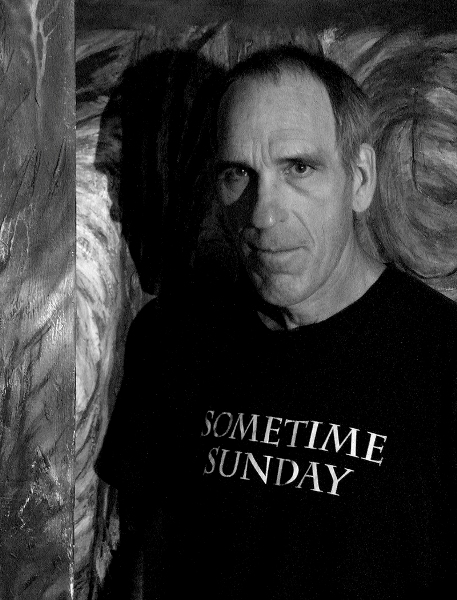
Doug Peterson: Dan, you were a founding member of Subterranean Café? Can you tell us about that band?
Dan Zimmerman: The band arose out of an idea. I wanted to form a group that witnessed for Christ by going UNDER the conscious wall of opposition to the gospel rather than continue the seemingly fruitless argumentative battering against it. Initially some kindred souls got together at my house to plan our attack, drafting what I called “The Subterranean Manifesto.” The drummer was Steve Bakunas, a vibrant and adventurous soul who had been touring with Circus Vargas when he decided to drop out of that and live with my family. I played him the songs I was writing. He decided to buy a drum set he saw at a pawnshop. We started practicing in our Portland living room in about 1982. The first name for the group was Gentle Dove and the Snake Crushers. Sean Boyle was the first bass player. In ’83 Bud Renderer became bassist. Blair Stevenson started recording us about that time (the first Subterranean Café album) and decided he wanted to play with us, things really began to jell. Blair passed on last year. I miss him a lot.
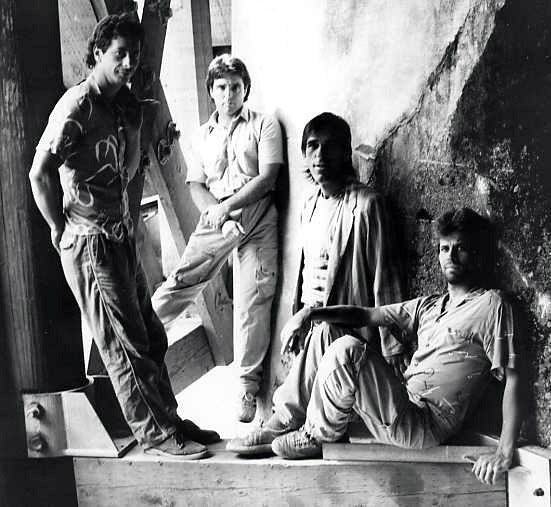
Subterranean Café, under bridge in Portland, 1985
Where did Subterranean Café play? What kind of venues, and what audience did you attract?
Well, I have to mention first that most musicians in the churches, including the very dynamic Jesus Movement churches, were worship leaders. Blair and I led worship in our respective churches. But the sixties had really ignited my creative imagination as to the possibilities of song writing. I wanted to express the spiritual drama in my heart out in the clubs and bars, through rock and roll! We played the Satyricon a lot. The owner George and I really hit it off. He had a Greek Orthodox background. We played alongside a Christian Motorcycle Club when they visited youth prisons, like the one in Naselle, Washington. A few adventurous small town churches like Eureka and Silverton G.O. and “Festivals of the Son” in California hosted us. Once we opened for Chuck Girard of Love Song, a very early Christian rock group. A good crowd had come to see him. I think we surprised them a bit. Gospel Outreach, my home fellowship, was a very bold and daring group in the eighties. They encouraged us for the most part. Oh, yes, we also played shows with other early Christian rock bands like Flock 14 at the Melody Ballroom and The Clergy at the X-Ray. I think we attracted the ears and hearts of those who were willing to allow themselves to admit they really dug us. I was never convinced we had much of a “following,” although a few years back I talked to Terry Scott Taylor and he said he knew of us.
You have also done some solo albums. Can you describe those projects?
Aside from the band albums with Subterranean Café and Threads of Gold, and the Sounds Familyre Records albums, I did 5 solo projects.
Tucson Recording (1969): My first record. A mix of original and cover songs recorded by Jim Brady (who still runs a studio in Tucson) with his high school bud, Michael Ronstadt, Linda’s brother.
Whatever (1971): An album cobbled together in Portland Oregon with Timothy Hill, dear friend and gifted son of a theatre family. Timothy graces my newest album, Dreams of Earth with his fine vocal harmony.
The Nursery Tapes (1978): Recorded on a borrowed reel to reel while working in Wind River Nursery, a government tree nursery in Washington state, just south of Mt. St Helens before she blew. The first time I sought to express my faith in song.
After the first two Subterranean Café albums, self-titled and When Dinosaurs Melt,
More At Stake (1986): Recorded at home on a Tascam 4-track cassette recorder. One of my favorite projects. An oddity for sure. Experimental stuff.
After the acoustic band Threads of Gold album and the 3rd Subterranean Café record, Right on Target, Stand By Night (1992): Produced by my loyal friend and brother, Tony Tuck, and recorded by Craig Russell. An album of hymns and original songs. Love songs for the brethren.
Then we moved to New Jersey where, thanks to Aron Noll, I got hooked up with Daniel Smith. So far I’ve done three Sounds Familyre albums, Great Small, Cosmic Patriot and Dreams of Earth.
Northwest Years (1999): A compilation CD produced by friend and colleague Tim McAllister. Selected tracks (both band and solo projects) from the 15 years I spent making music in Portland.

I absolutely love the lyric/illustration book that accompanied your self-titled Subterranean Café tape. It is one of my favourite artistic endeavors for any tape I’ve owned. What merits have that tape/booklet received?
Merits received? Just the kind and perceptive expressions of appreciation from kindred hearts like your own here and there through the years. When I was very young (about 9) in South Central L.A. circa 1957 I used to make little illustrated books with my oldest creative friend Robert Illes (who went on to become an Emmy winning television writer). His character was a detective and mine was a cowboy. We are still fast friends and often talk about making books again. I am thinking about a graphic novel memoir.
What musical artists or bands inspire you?
My father, Gilbert S. Zimmerman, was my greatest musical inspiration. He was originally going to become a professional singer. He sang in a quartet (in the thirties) alongside the great John Raitt, Bonnie’s father. But then he became a Methodist minister.
Hymns…certain ineffably deep and majestic hymns from the Methodist hymnal.
The beauty of fifties rock n’ roll. Innumerable marvelous classic songs. Truly the Golden Age of American Rock n’ Roll. Elvis Presley at Sun Studios. Ricky Nelson and his band, The Everly Brothers.
The seemingly limitless possibilities of music exemplified by the sixties. Bob Dylan opened up for me the lyric potential of song. Tim Buckley (and later Jeff, his gifted son), Fred Neil, Tim Hardin. I also loved Jimi Hendrix, Frank Zappa, the Stones. The Beatles were huge of course; they were both rock n’ roll and classical.
The beauty of several distinctly different things happening at once. The torque and synergy of rockabilly. Vocal harmony. The contrapuntal sublimnity of Johann Sebastian Bach, the Everly Brothers, the Byrds, Fleet Foxes.
During the last twenty years I’ve been moved by seemingly disparate and different artists. The Ramones, Gram Parsons, Arcade Fire, Big Star, Television, and The Replacements.
I must admit, especially recently, there’s a great amount of what to me is terrible music being made. I almost feel like I need to shield myself from it. I speak especially of what today is considered “pop” or what is championed by the current rage, music “talent” shows. The award shows are almost unendurable for me.

Soft Avon
Let’s hear about your paintings. How did you begin painting? What is/are your preferred style of painting?
I began to draw first, before I wrote, before I took up guitar. Drawing is the way one begins to paint. I did a few sporadic paintings in the early sixties, and then of course when I studied painting in college at Syracuse University. But it wasn’t until the late eighties that I began to consistently keep my hand in. Typically I will go out and do a lot of drawing. Recently I’ve been leaning more and more on charcoal as my favorite drawing medium. Eventually I come up with a few drawings that want to be transposed into paintings. In painting I prefer oil. It stays workable longer. And it has weight.
Some of the paintings I’ve seen of yours hold so much imagination and depth. It is almost as if you are looking out of a window or over a balcony into something lush and breathtaking. Other paintings are like snapshots while in motion of an event that is captivating and fluid. Do you start with a concept or do you let your paintings evolve?
I think what you are attempting to describe is the very thing that draws me to the creative process. In this world do we not feel captive? The march of time presses us inexorably forward. Space holds us within each particular confine we happen to be in. And yet we know in our spirit that there is much more to life. Inwardly we know that, in truth, we are free in Christ. But our desire is that the outward would commingle with the inward. We turn to our calling as makers, and co-creators. In and through the creative process our feeling of captivity is overcome and transcended. We reach a promontory, the sort of balcony you referred to, and suddenly find we can look backwards and forwards in time. And Space does not wall us in. The canvas becomes a portal, a means of walking through walls.

Joy Foam
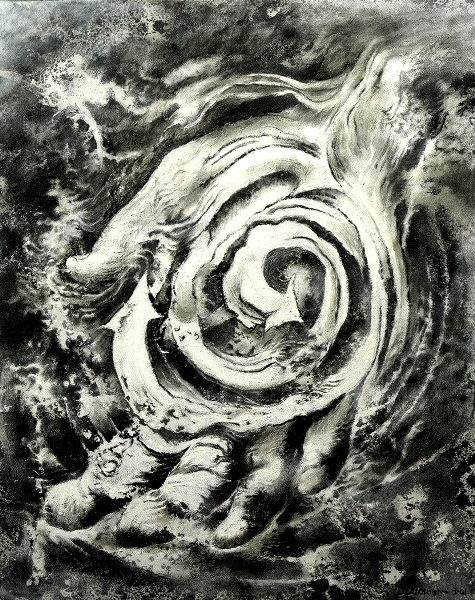
Hand of the Maker
Does your art get shown at places or exhibits? Do you do paintings on commission?
I’ve shown some. Some juried exhibits. Some music shows where I bring paintings along to display while I play. Sometimes they project paintings/images on a screen behind me like at the Knitting Factory in New York.

Dan at the Knitting Factory, NYC
I have not been satisfied with the experience of doing commissions in the past. I would consider a commission, however, if the painting can be based on a pre-existent drawing of mine.
Who are your favourite painters, both historically and in contemporary art?
Expressionism. Vincent Van Gogh, Chaim Soutine, Charles Burchfield, Marsden Hartley, Jackson Pollock. The black and white expressionist vein of film has also influenced me deeply (as reflected in the b&w paintings done from ’92 to 2002, and my black& white sci-fi film, Space Pilgrim, which can be seen on YouTube).
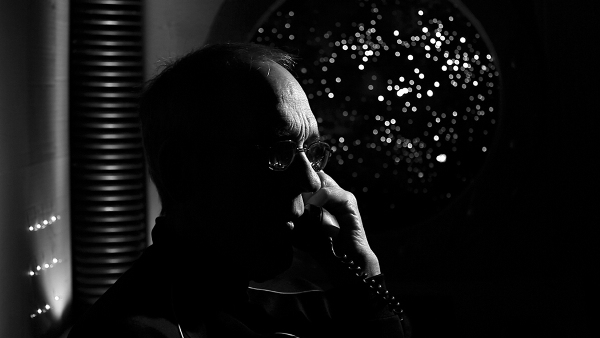
by Malachi Matcho, from “Space Pilgrim”
Other artists and influences which were big for me are Wassily Kandinsky, Emily Carr, Mad Magazine (the earliest issues), Famous Monsters of Filmland, Giotto, Arthur Dove, Pinkham Ryder, Gustave Dore, Dostoyevsky, and Thomas Mann.
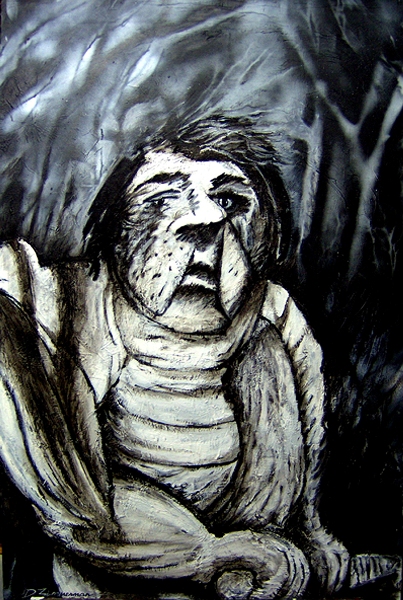
Dogman
I used to see your drawings in the high-end audio magazine, Positive Feedback, which was edited by our mutual friend, David Robinson. I always knew they were your drawings because they had a unique caricature all of their own. They would contain a caption from our faith tradition which was both clever and subtle. Describe the kind of imagination you envisioned to capture with those illustrations.
David Robinson has been a dear friend and a profound encouragement to me as an artist for many years. The Positive Feedback drawings were kicked off by discussions David and I would have. They were fragmentary visions, springboards for inconclusive reflection. I wanted each drawing to be, as Denis de Rougement so aptly described, a work of art, “a trap for meditation.” I know, it sounds like the Subterranean Manifesto all over again.
How do you approach faith with art? Do you understand being an artist as a vocation?

Muse
You can only become what you are. I don’t remember who said that, but it’s true. If an artist does not see their creative work as a vocation – a calling, how will they endure? There is a constant temptation to feel guilty about what you do, because it serves no “useful” purpose as far as the world system is concerned, and often in the church as well, a situation which is most grievous. I begin to quote Nicolas Berdyaev. He has probably had a greater influence on me than any human, besides my father. His writing provided a spiritual context for my calling as an artist. He wrote so many powerful and pertinent things concerning the creative act. I don’t recall the exact wording, but he said that an artist is continually under pressure to justify their work. In truth, however, the artist is justified BY their work.

The Mist of Comfort
Nicolai Berdyaev said that freedom is an essential element of human life and that human creativeness is complementary to God’s creativeness. How has this held out in your own creative journey?
It was for freedom that Christ set us free. In my life, the most potent experiences of freedom I have felt have been during the emergence of a new work, whether it be when the band is performing a new song for the first time, or when a new painting is taking shape seemingly out of nothing. Berdyaev, I believe, was way out there, ahead of us on the road. He intimated that we would have a direct hand in the transfiguration of all things. What is the New Jerusalem? If the Kingdom of God is within us, what will the Second Coming be? Just what IS a New Heaven and a New Earth? I quote Berdyaev: “Art is a creative breakthrough into a transfigured world, and its meaning lies in the fact that it is the anticipation of the transfiguration of the world.” Creativity and freedom are inextricably intertwined.

Mowing the Lawn
I see on your Facebook page that you’ve been playing lately as Dan Zimmerman & The Torquebillies? How would you describe the music you guys do?
The term Torquebilly is reflective of the music we play. It has substantial torque and a bit of billy. Like my music has always been, these are pilgrim songs, filled this time with a more complex weave of guitar music, in a bed of sweet vocal harmonies. And yet it really rocks at certain junctures. Call it ethereal grit. Imagine a seeker wandering through Memphis. I believe at the time these songs were evolving, Tony and I were listening to a lot of Gram Parsons, classic country, rockabilly… so these influences are evident.
Tony Jones, my fast friend and guitar mate, happens to be from England, the Midlands to be exact. Why is it that we need the Brits to remind us of our Nation’s musical riches? He plays a sweet electric lead line typically around and over my acoustic guitar. Wayne Taussig on bass and Adrian Valosin on drums round out the Torquebillies.
On the album Dreams of Earth we are graced with gorgeous supporting vocals from Timothy Hill and Elin K. Smith. Timothy is one of the few people whose vocal timbre really compliments mine. As noted before, we had collaborated before on an album in Portland in 1971. Elin K. Smith, of the pioneering group Danielson, wife of my longtime compatriot and producer at Sounds Familyre Records, Daniel Smith, has a gorgeously delicate way of singing over the top of the proceedings.
How can people purchase your music or buy art from you?
Soundsfamilyre.com for Northwest Years and my last three albums. I am currently working on transferring all the other recordings (previously on aging cassettes) to CDs, and will announce these when the project has been completed. I am also developing a web site to display and make my paintings and drawings available for purchase.
In the meantime I intend to upload examples of my visual work onto Facebook, where I have both a personal page and a “Dan Zimmerman & the Torquebillies” band page.
The art work I intend to organize into photo albums on my personal Facebook page. Anyone interested in purchasing pieces could initiate an inquiry by sending me a personal message there. Interested people can also go to soundsfamilyre.com where links to all sites I develop will be found.
Parting thoughts?
I am so grateful for this. Thank-you, Doug. Thank-you editors of Down The Line.
In closing, I would express the hope that these things might embolden fellow artists of faith. Berdyaev described the creative calling as “the sainthood of daring.” Art as witness. I believe there are many kindred out there who don’t even know it yet. My wife, Robin, and I often quote a writer (forgot the name) who stated that “the way to the universal was through the intensely personal.” When Jesus said “I AM the door,” I believe the emphasis was upon Being as much as it was upon Access. By exploring the creative freedom of being in Christ we disclose the beauty of the Kingdom. For why would someone want to go through the door if they saw nothing beautiful, if they saw nothing desirable, nothing which they already identified with or yearned for?
I continue to be moved by what Leslie Fiedler said of Simone Weil: “She was planted at the intersection of Christianity and everything that is not Christianity. She refused to cut herself off from anyone…” We become who we are as we see something of ourselves in everything and everyone else.
Or, as Teilhard de Chardin said, “Everything that rises must converge.”

Torquebillies, Princeton B & N, Sept. 2013

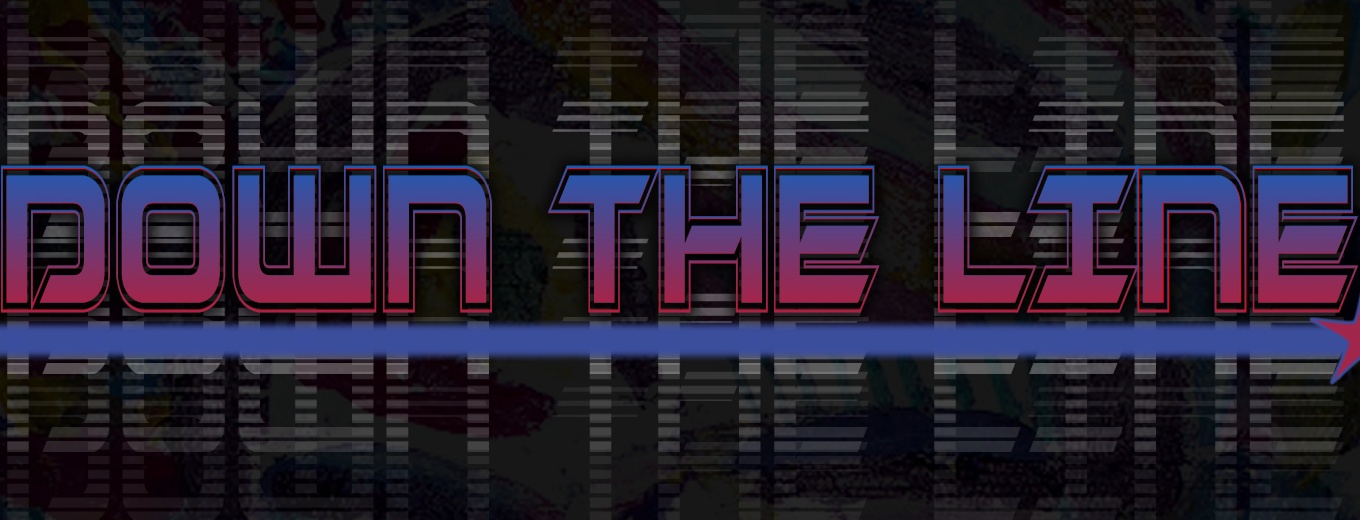
Leave a Reply